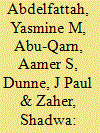| Srl | Item |
| 1 |
ID:
166737


|
|
|
|
|
| Summary/Abstract |
This article investigates the demand for military expenditure for a sample of key Asia-Pacific countries. Spatial panel demand estimates are presented for three joined spatial units using a fixed-coefficient spatial lag model based on a two-step efficient GMM estimator. Spatial autoregression estimates are next presented for 1991–2015, founded on alternative kinds of country connectivities, such as contiguity, inverse distance, discrete distance, and power-projection considerations. Finally, 11 select countries’ demands for defense equations are estimated using seemingly unrelated regressions. From alternative perspectives, these estimated models indicate how Asia-Pacific countries respond to the defense spending of other countries. In the spatial runs, free riding is prevalent despite the growing military might of China, which apparently is not generally viewed as a threat. For the sample period, the projection of Chinese or American power is a relevant spatial factor. The main threat is reflected in non-U.S. allies’ reaction to U.S. allies’ defense spending during 1991–2015 and to Chinese defense spending after 2002.
|
|
|
|
|
|
|
|
|
|
|
|
|
|
|
|
| 2 |
ID:
129826


|
|
|
|
|
| Publication |
2014.
|
| Summary/Abstract |
Egypt plays a pivotal role in the security of the Middle East as the doorway to Europe and its military expenditure reflects its involvement in the machinations of such an unstable region, showing considerable variation over the last 40?years. These characteristics make it a particularly interesting case study of the determinants of military spending. This paper specifies and estimates an econometric model of the Egyptian demand for military spending, taking into account important strategic and political factors. Both economic and strategic factors are found to play a role in determining military burden/spending, with clear positive effects of lagged military burden, suggesting some sort of institutional inertia, plus negative output and net exports effects. The strategic effect as a result of the impact of Israel's military burden is mostly positive and significant, though its impact is reduced when the impact of important strategic events are taken into account. The military spending of Egypt's allies Jordan and Syria generally seems to have had no effect on Egypt's spending. These results are consistent over a range of econometric techniques.
|
|
|
|
|
|
|
|
|
|
|
|
|
|
|
|
| 3 |
ID:
185484


|
|
|
|
|
| Summary/Abstract |
One of the outcomes of the 2014 North Atlantic Treaty Organization (NATO) Summit held in Wales was the recommendation that allies should strive towards spending at least 2% of their Gross Domestic Product (GDP) on military expenditure by 2024. This has in recent years put the debate on burden sharing within the Alliance in the limelight. Within the Alliance, the interpretation of the guidelines is different. This is partly because the U.S.A, especially under President Trump, has consistently viewed the 2-% guideline as a binding agreement. Some allies have, however, indicated that their military expenditure will not increase to the recommended threshold by the set deadline. Critics of the guideline have also identified several shortfalls associated with it and consequently dismissed it. Those who support it emphasize for instance that it contributes to addressing grievances about free riding within the Alliance. This paper contributes to this discussion and literature on demand for military expenditure by assessing how NATO’s two percent guideline can be viewed from a demand for military expenditure perspective. It also proposes and estimates a dynamic panel model for this purpose. Empirical evidence presented suggests that fiscal conditions require attention in the debate on the two percent guideline.
|
|
|
|
|
|
|
|
|
|
|
|
|
|
|
|